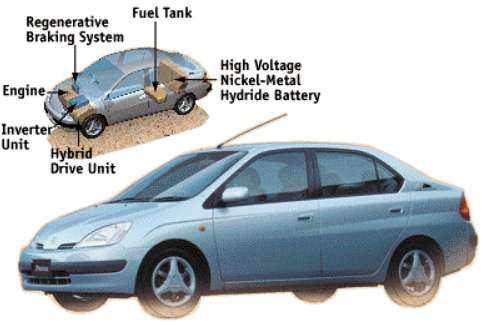| Hybrids |
|
The Toyota Prius - A Case Study |
|
The Toyota Hybrid System in the "Prius" is an example of a "hyper car". Not only does the vehicle use more than one fuel, its design is optimised to increase energy efficiency. The root of the problem is that cars are very inefficient. Only about 15-20 percent of the fuel energy makes it to the wheels of a typical car, and of that, only a small fraction goes into the comfortable, effective, and safe transport of driver and passengers. The rest, most of the original fuel energy, goes into excessive heating of the air, tires, brakes, and road. Making cars more efficient is a matter of minimising energy losses through the use of ultralight construction, low-drag design, hybrid-electric drive and efficient accessories. Based on Japanese tests, the Prius emits gets twice the mileage, which means 50% less output of carbon dioxide and 90% less carbon monoxide, hydrocarbon, and nitrogen oxide emissions. It has both a petrol engine and two electric motors and although more expensive, the fuel savings mean that drivers are paid back over the vehicle lifetime. According to Toyota, "hybrid cars outperform pure-electric vehicles in charging time, driving range, and cost, and outperform conventional vehicles in terms of improving fuel economy and reducing emissions". Some hybrid systems use their engine just to generate electricity for charging the batteries to run the electric motor. Others use the engine and motor alternately, depending on the driving conditions. The Prius uses a continuously variable combination of petrol and electric power to maximise energy efficiency and minimise emissions. |

|
| The Toyota Prius |